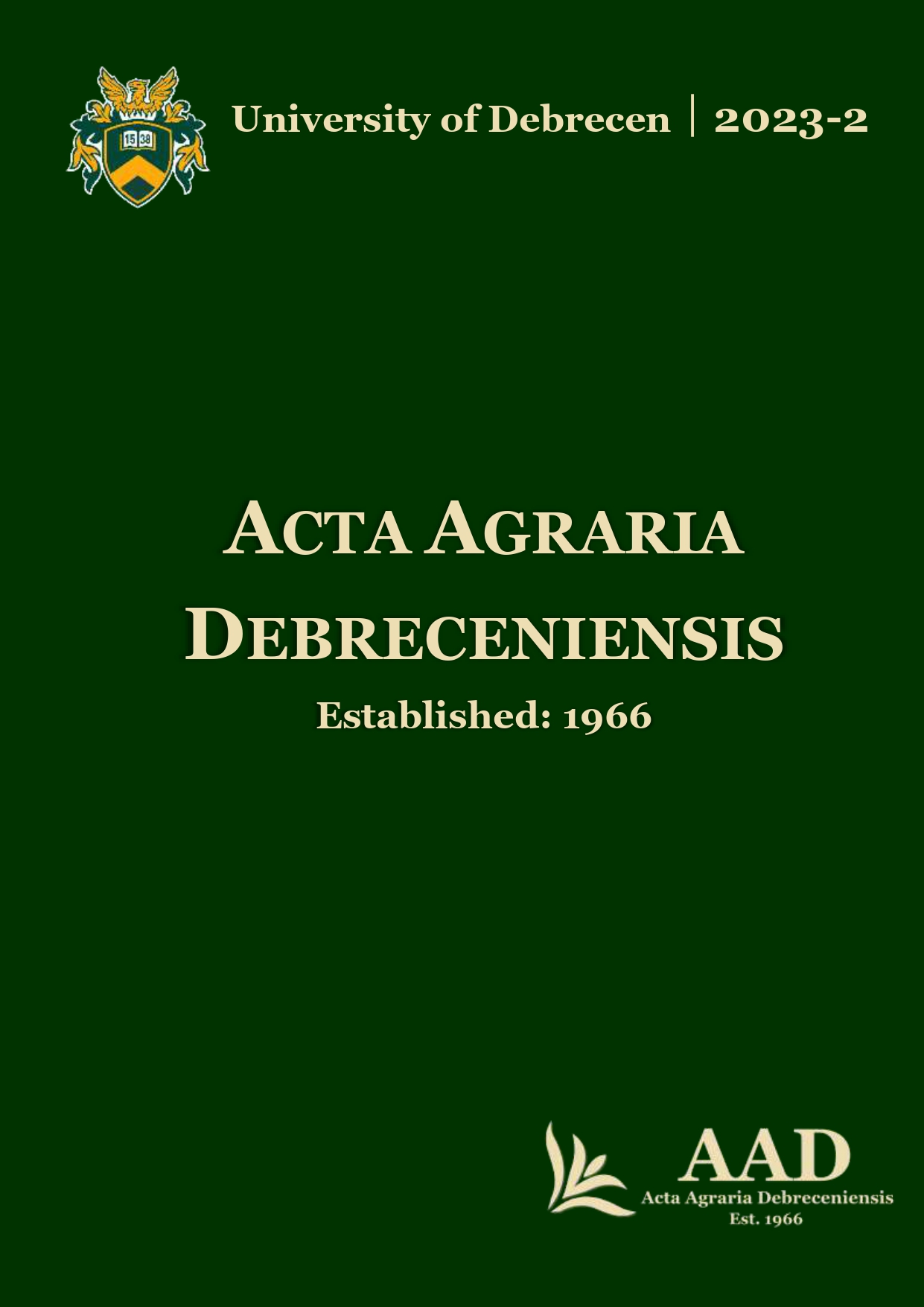Effect of sufficient and deficit irrigation with different salt inputs on the yield of cucumber
Authors
View
Keywords
License
Copyright (c) 2023 by the Author(s)

This work is licensed under a Creative Commons Attribution 4.0 International License.
How To Cite
Accepted 2023-06-12
Published 2023-12-01
Abstract
Soil salinisation is considered one of the major environmental hazards threatening agricultural productivity and can be accentuated by climate change as well as the use of low-quality water in irrigation. This is the case in our study area which is affected by secondary salinisation due to the use of saline irrigation water for horticultural production. Deficit irrigation technique is implemented especially in arid and semiarid regions due to its potential to optimise water productivity while maintaining or increasing crop yield. The main objective of this study was to compare the effect of irrigation with sufficient (SD) and deficit (DD) doses. This research was carried out in Karcag in 2020. Cucumber was grown on a meadow chernozem soil and was irrigated with SD and DD of two irrigation water qualities. Soil moisture was monitored and crop yields were recorded. Despite the differences in quality and quantity of water, the application of less water by DD maintained the same yield as SD. We found a non-significant difference between the average soil moisture contents under the treatments (15.5 v/v% for SD and 13.5 v/v% for DD). Deficit irrigation can be an efficient technique due to its potential for improving water use efficiency, maintaining sufficient soil moisture content favourable for proper crop development and yield.
References
- Arshad, I. (2017): Effect of water stress on the growth and yield of greenhouse cucumber (Cucumis sativus L.). PSM Biological Research Vol.2:263–67. ISSN: 2517-9586 https://psmjournals.org/index.php/biolres/article/download/61/35
- Chai, Q.–Gan, Y.–Turner, N.C.–Zhang, R.–Yang, C.–Niu, Y.–Siddique, K.H.M. (2014): Water-saving innovations in Chinese agriculture, Ed.: Donald L. Sparks, Advances in Agronomy, Academic Press, Vol. 126, https://doi.org/10.1016/B978-0-12-800132-5.00002-X.
- Chhabra, R. (1996): Soil Salinity and Water Quality. CRC Press. pp. 1–300. ISBN: 90 5410 727 8
- Falkenmark, M.–Rockström, J. (2004): Balancing water for humans and nature. The New Approach in Ecohydrology, 1–247 pp., Earthscan, London. ISBN: 1-85383-927-2
- FAO (2002): Agricultural drainage water management in arid and semi-arid areas. Irrigation and Drainage Paper 61. Rome. ISBN: 92-5-104839-8. https://halophyteskh.biosaline.org/sites/default/files/content/MarginalResources_MWater/ACArid%28FAO61%29.pdf
- Fereres, E.–Soriano, M.A. (2007): Deficit irrigation for reducing agricultural water use. Journal of Experimental Botany. Vol. 58:2. pp. 147–159. https://doi.org/10.1093/jxb/erl165
- Martinez, L.–Thornsbury, S.–Nagai, T. (2006): Agricultural Economics Report. National and International Factors in Pickle Markets. Department of Agricultural Economics Michigan State University East Lansing. pp. 1–20. https://core.ac.uk/download/pdf/6407521.pdf
- Mohamed, E.–Belal, A.A.–Ali, R.R.–Saleh, A.–Hendawy, E.A. (2019): Land degradation. In [The Soils of Egypt]. World Soils Book Series. 159–174. https://doi.org/10.1007/978-3-319-95516-2
- Morvan, X.–Saby, N.P.A.–Arrouays, D.–Le Bas, C.–Jones, R.J.A.–Verheijen, F.G.A.–Bellamy P.H.–Stephens, M.–Kibblewhite, M.G. (2008): Soil monitoring in Europe: A review of existing systems and requirements for harmonisation. Science of the total environment. 1–12. https://doi.org/10.1016/j.scitotenv.2007.10.046
- Okur, B.–Örçen, N. (2020): Soil salinisation and climate change. In Climate Change and Soil Interactions. Elsevier. 331–350. DOI: 10.1016/B978-0-12-818032-7.00012-6
- Ondrasek, G.–Rengel, Z.–Veres, S. (2011): Soil salinisation and salt stress in crop production. In: Abiotic Stress in Plants - Mechanisms and Adaptations. 442p. DOI: 10.5772/22248
- Plaut, Z.–Edelstein, M.–Ben-Hur, M. (2013): Overcoming salinity barriers to crop production using traditional method. Critical Reviews in Plant Sciences. 250–291. https://doi.org/10.1080/07352689.2012.752236
- Pulido-Bosch, A.–Rigol-Sanchez, J.P.–Vallejos, A.–Andreu, J.M.–Ceron, J.C., Molina-Sanchez, L.–Sola, F. (2018): Impacts of agricultural irrigation on groundwater salinity. Environmental Earth Sciences. 77(5). 1–14. pp. https://rua.ua.es/dspace/bitstream/10045/74239/5/2018_Pulido-Bosch_etal_EnvironmEarthSci_revised.pdf
- Qadir, M.–Oster, J.D. (2004): Crop and irrigation management strategies for saline-sodic soils and waters aimed at environmentally sustainable agriculture. Science of the Total Environment. 1–19. https://doi.org/10.1016/j.scitotenv.2003.10.012
- Rivera, A.–Tuba, G.–Czellér, K.–Kovács, Gy.–Zsembeli, J. (2020): Mitigation of the effect of secondary salinisation by micro soil conditioning. Acta Agraria Debreceniensis. 115–119. https://doi.org/10.34101/actaagrar/1/3720
- Shaingberg, I.–Letey, J. (1984): Response of soils to Sodic and Saline Conditions. Journal of agricultural science. 52(2), 1–57. DOI:10.3733/hilg.v52n02p057
- Shetty, N.V.–Wehner, T.C. (2002): Screening the Cucumber Germplasm Collection for Fruit Yield and Quality. Crop Science. 2174–2183. https://doi.org/10.2135/cropsci2002.2174
- Sidhu, R.K.–Kumar, R.–Rana, P.S.–Jat, M.L. (2021): Automation in drip irrigation for enhancing water use efficiency in cereal systems of South Asia: Status and prospects, Ed.: Donald L. Sparks, Advances in Agronomy, Academic Press, Vol.167, https://doi.org/10.1016/bs.agron.2021.01.002.
- Wehner, T.C.–Guner, N. (2004): Growth stage, flowering pattern, yield and harvest date prediction of four types of cucumber tested at 10 planting dates. Acta Horticulture. 223–230. 10.17660/ActaHortic.2004.637.27
- Zsembeli, J.–Kovács, Gy.–Tuba, G.–Czellér, K.–Juhász, Cs. (2019a): Climate change at local level on the base of the air temperature and precipitation data of the weather station of Karcag. In: Creating a platform to address the techniques used in creation and protection of environment and in economic management of water in the soil. Outputs from the project Visegrad fund. Visegrad Grant No. 21730049 43–49. http://visegradfund.mendelu.cz/wcd/w-rek-visegradfund/resume.pdf
- Zsembeli, J.–Sinka, L.–Rivera-García, A.–Czellér, K.–Tuba, G.–Krištof, K.–Findura, P. (2019b): Effect of soil conditioning on the moisture content and the salt profile of the soil under irrigation with saline water. Polnohospodarstvo-Agriculture 65. 77–87. DOI: https://doi.org/10.2478/agri-2019-0008
- Zsembeli, J.–Szűcs, L.–Blaskó, L. (2011): Secondary salinisation by irrigation from drilled wells in Karcag area. Növénytermelés 60 (Suppl) pp. 305–308.

 https://doi.org/10.34101/actaagrar/2/12421
https://doi.org/10.34101/actaagrar/2/12421